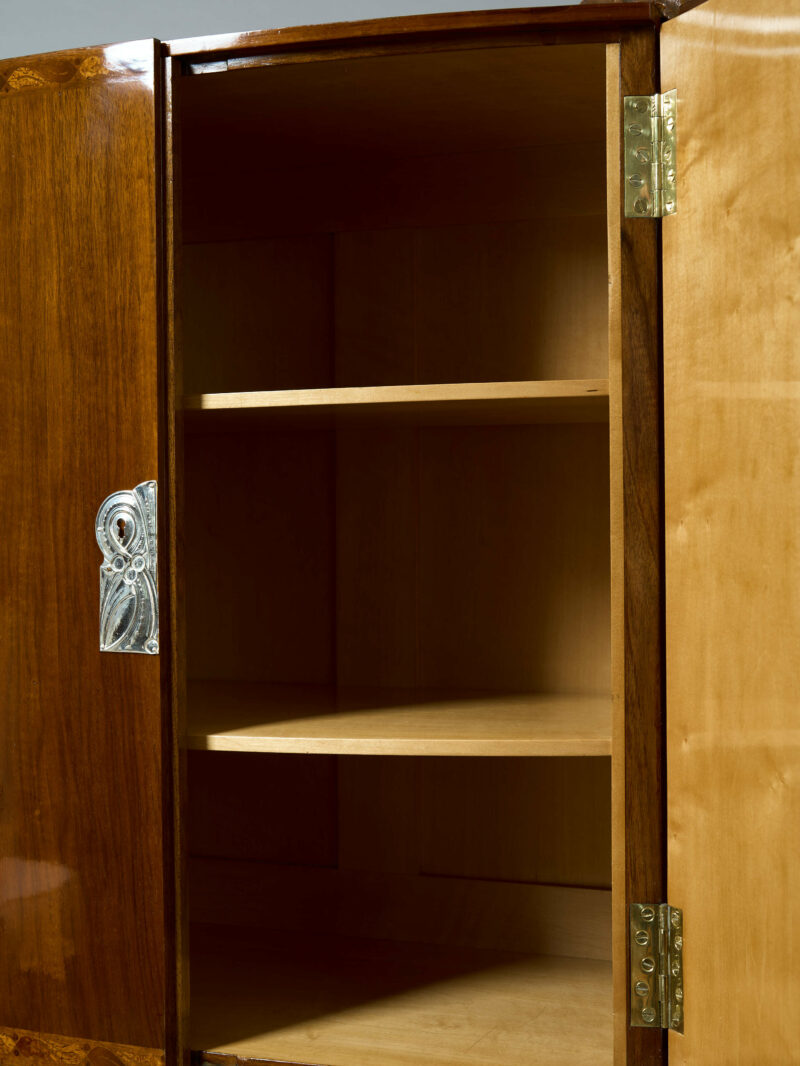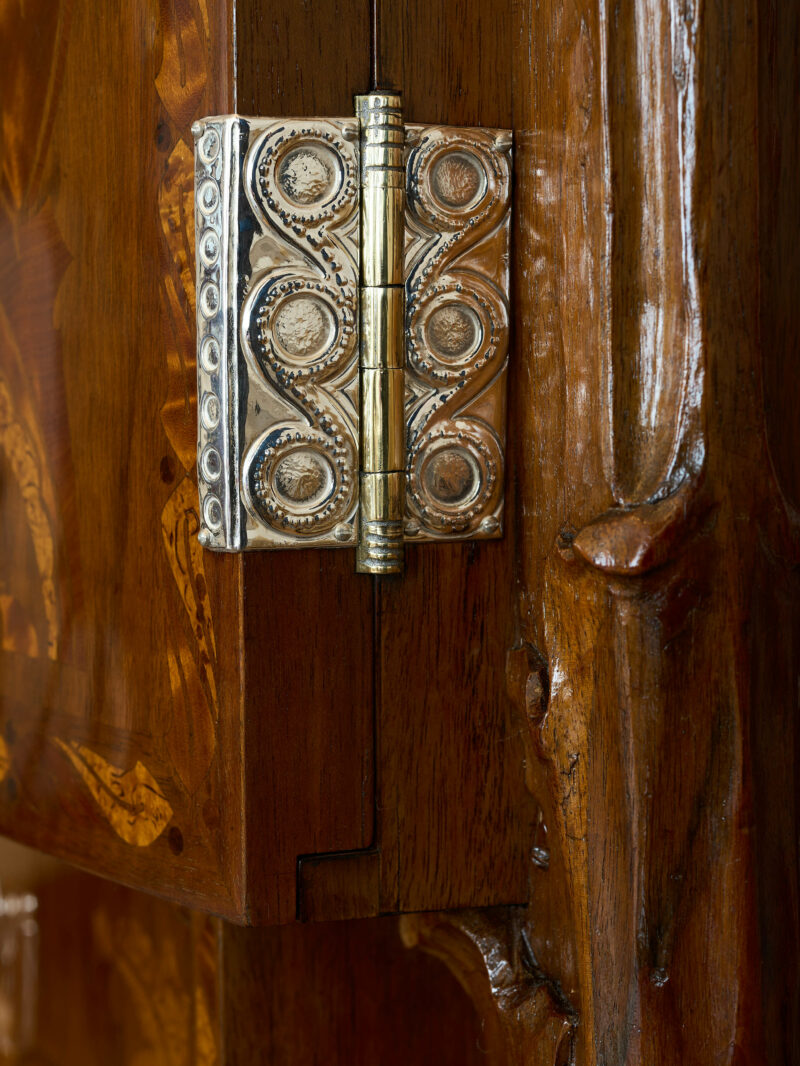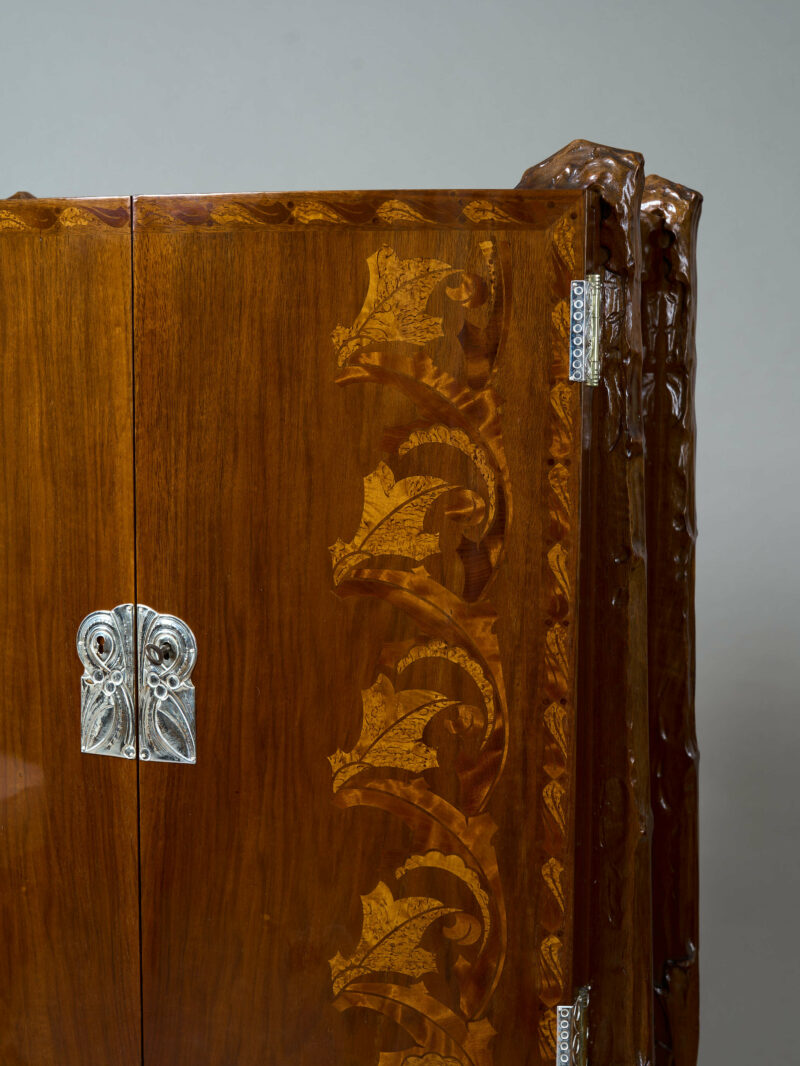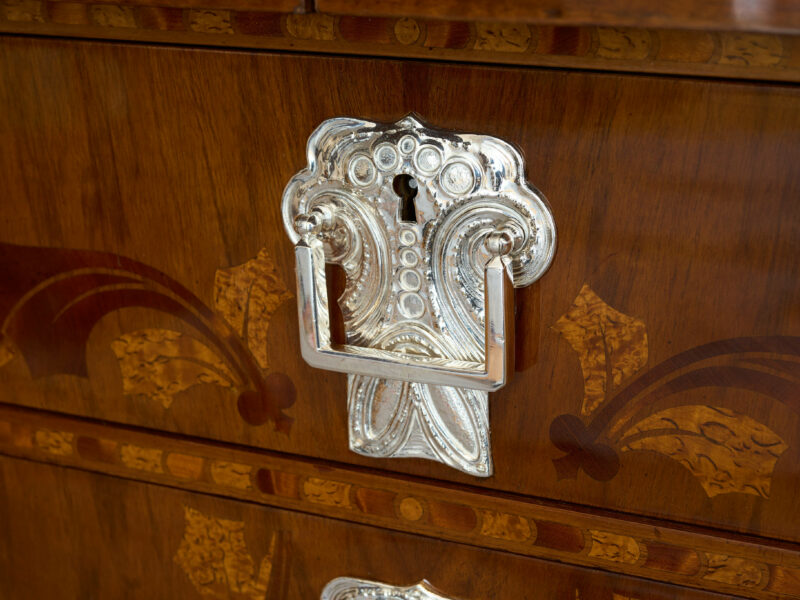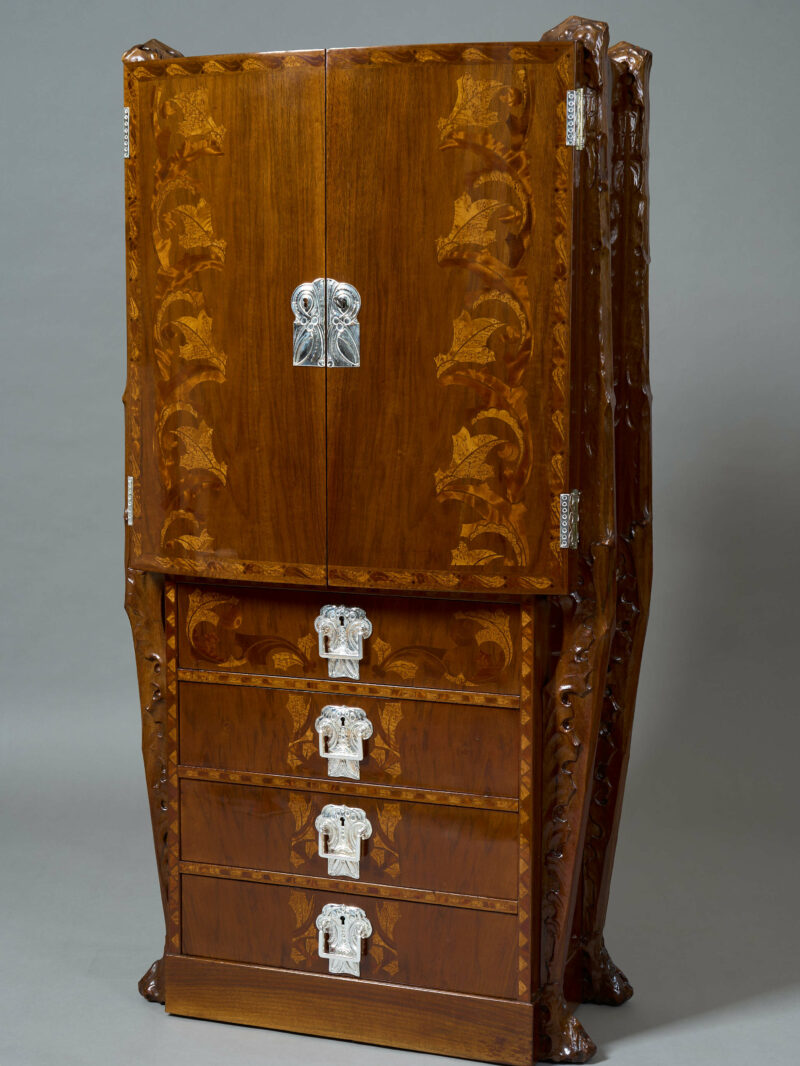
Viennese Cabinet, around 1906/10
By Bernhard Ludwig, "k.u.k" (Imperial and Royal) Austrian and Royal Romanian Court Cabinetmaker and Furniture Manufacturer
Elaborately Crafted Furniture Piece by the renowned Viennese Furniture Manufacturer Bernhard Ludwig.
Two stacked cubic elements rest on a closed plinth. The upper section is broader and overhanging, featuring two doors and a convex front, with two compartments inside. The lower section, which sits directly on the plinth, contains four drawers.What makes this design exceptional — besides the intricate marquetry and fittings — are the four richly carved side elements adorned with foliage, which visually embrace the piece from root to crown with vine-like leaf motifs. The richly Art Nouveau-styled brass fittings are executed in silver-plated repoussé work. The exterior of the piece is veneered in walnut, while the interior is finished in birch. The lavish inlays are crafted from fine veneers such as thuja, maple, and rosewood.
All locks are signed “Bernhard Ludwig Wien” and numbered 839. This exceptional piece, most likely produced in very limited quantities and usually made to custom order, was part of a dining room ensemble design titled Heimat and referred to in preserved records as a “silver cabinet.“
An identical dining room ensemble is held in the collection of the Museum of Applied Arts (MAK) in Vienna.
A detailed documentation of this furniture can be found in the literature: Vera J. Behal, “Möbel des Jugendstils”, Collection of the Austrian Museum of Applied Arts, Vienna, illustration on page 197, no. 149.
Bernhard Ludwig was among the leading furniture manufacturers in the Austro-Hungarian Danube Monarchy. As a furniture and interior outfitter with branches in Vienna, Brno, Trieste, Bucharest, Cairo, and Alexandria, the company made both simple furniture in series as well as high-quality interiors. It operated internationally, furnishing castles and residences, including those of the Romanian royal court. Additionally, Ludwig, as a court cabinetmaker of the Historicist era, played a key role in the development of Vienna’s Ringstrasse, contributing to the interiors of the Palace of Justice, Parliament, and the Burgtheater.
Beyond his work as a furniture outfitter, Ludwig earned a reputation as an inventive creator of various devices and techniques, such as the branding iron, the water motor, and the veneer peeling machine.
In addition to his extensive production, the company participated in numerous international exhibitions, including the 1873 World’s Fair in Vienna, the 1883 International Electrical Exhibition in Vienna, the 1888 Jubilee Trade Exhibition in Vienna, the 1888 World’s Fair in Barcelona, the 1898 Jubilee Exhibition in Vienna, the 1903 – 1904 Winter Exhibition at the Imperial Royal Austrian Museum of Art and Industry in Vienna, the 1906 Imperial-Royal Austrian Exhibition in London, and the 1908 Kunstschau in Vienna. History:
The furniture workshop “Bernhard Ludwig” was founded by its namesake, Bernhard Hieronymus Ludwig (March 2, 1834, Mülsen St. Jakob – September 12, 1897, Vienna). He learned the trade of carpentry from his father, Johann August Ludwig (June 26, 1796 – June 12, 1875) in Mülsen, Saxony. After completing his training in his father’s workshop between 1848 and 1850, Ludwig embarked on a journeyman’s tour in June 1851. This led him from Leipzig, Halle, Braunschweig, and Wolfenbüttel to Hamburg, where he stayed for two years and took drawing lessons. After being discharged from military service in his homeland, Ludwig arrived in Vienna in 1855 via Prague, where he initially worked as a carpenter’s assistant and workshop foreman for Michael Winter, Philipp Schmidt, Bernhard Wörmann, Theodor Uhl, and Andreas Matyasovsky.
At the same time, he attended the private drawing school of Gottlob Göhre (d. 1858⁄59) in Vienna’s Gumpendorfer Straße 117, established in 1852. Thanks to his remarkable drawing talent, he stood out quickly. In May 1858, Ludwig completed a sculpture training under Heinrich Becker (d. September 1871), who also worked at that location. After Göhre’s death, Ludwig briefly took over his drawing school. In April 1862, he was granted Austrian citizenship, and on November 20 of the same year, he opened his own drawing school for carpenters — initially located at Windmühle 108, and from 1863, also in Gumpendorfer Straße 117, Vienna VI. The school likely remained in operation until 1864. Its funding came from the income generated by a wooden washing machine he patented in 1860 and successfully marketed throughout the monarchy.
In 1867, Ludwig established his own carpentry workshop at the same Gumpendorfer Straße 117 address. Among his first employees was August Friedrich Ungethüm (November 4, 1834 – September 30, 1909), who would later become a renowned art furniture manufacturer. During this time, Ludwig received numerous commissions for furniture and interior decorations from noble and upper-bourgeois families, including the Liechtenstein, Karoly, György, Volpini, Hutter, and Cilli families.
The year 1873 was both a blessing and a curse: while he enjoyed success at the Vienna World’s Fair, a devastating fire destroyed much of his workshop. In 1874, he was granted the prestigious title of Imperial and Royal Court Supplier (k.k. Hoflieferant). That same year, he temporarily relocated to Mariahilfer Straße 73 and Esterházygasse 24, before settling in Münzwardeingasse 2 in Vienna VI in 1877. He also established satellite branches in Suben, Upper Austria, and in Karthaus (Valdice), Bohemia. In 1878, he was named Imperial and Royal Austrian and Romanian Court Cabinetmaker (k.u.k. österr. und königl. rumän. Hof-Kunsttischler).
At the 1883 International Electrical Exhibition in Vienna, Ludwig presented his self-invented electric branding iron, which he later replaced with his patented pyrography (brand technique). This cost-effective method enabled the creation of flat and high reliefs in wood and served as a substitute for intricate inlay work. His invention drew international interest, and he licensed patents in Great Britain and the USA.
In 1886, another store was opened at Großer Platz 14 in Brno, Czech Republic. In 1889, architect Carl Langhammer (1840 – 1906) was commissioned to convert the headquarters at Münzwardeingasse 2 into a representative residential and commercial building, into which the family moved in 1892. The basement and first floor served exhibition purposes, while the upper floors became their private residence.
Due to growing success and demand, a second factory with a sawmill and construction joinery was planned near the Liesing train station in Vienna XXIII in 1895. The design was handled by Ludwig’s eldest son and namesake, architect Bernhard Ludwig (August 16, 1866 – November 29, 1939), together with Ferdinand Franz Berehinak (May 6, 1863 – July 11, 1927). The 63-year-old founder did not live to see its completion — he passed away on September 12, 1897.
After Bernhard Ludwig’s death, his widow Pauline Ludwig, née Janik (January 15, 1842 – August 22, 1913), and his son Bernhard Ludwig continued running the company. In 1898, the son was also granted the title of Imperial and Royal Court Supplier (k.k. Hoflieferant) and successfully expanded the company until World War I.
In 1897, a relationship with King Carol I of Romania, a patron of the arts, brought the firm major commissions for furnishing royal palaces in Sinaia (Pelișor, Peleș, and Foișor) and Cotroceni Palace in Bucharest.
In 1900, the Brno location moved from Großer Platz 14 to Basteigasse 18, and in 1907 to Basteigasse 4. In 1905, another branch opened at Via Stadion 16 in Trieste. From May 16, 1916, Bernhard Ludwig’s wife Eugenie Ludwig, née Vaugoin (December 30, 1873 – November 5, 1950), became authorized signatory of the business. She came from the long-established silversmith dynasty “Jarosinski & Vaugoin.” By the outbreak of World War I, the firm employed 400 to 500 workers.
However, the aftermath of the war and the Great Depression forced the company to close the Liesing factory in 1929. On September 15, 1942, the business passed to Ludwig’s daughter Pauline Hanreich-Ludwig (September 30, 1916 – December 13, 1998). On March 29, 1943, the Trieste branch was dissolved. On January 1, 1970, the company was converted into a limited partnership, with Pauline Hanreich-Ludwig and Dipl.-Ing. and politician Georg Hanreich (b. October 22, 1939, Vienna) as partners. In 1976, the company filed for bankruptcy.
The legacy of the family business lives on through the Bernhard Ludwig Archive, managed by Bernhard Hanreich (b. June 7, 1945, Suben), brother of Georg Hanreich, and through the Kreativfabrik B. Ludwig Ges.m.b.H., an artist studio hub located in the former factory buildings at Münzwardeingasse in Vienna VI. A furniture restoration workshop is operated at Feldegg Castle in Pram, Upper Austria, by Georg Hanreich’s son, Bernhard Hanreich (b. August 29, 1967, Vienna).
Literature:
“Wagner, Hoffmann, Loos und das Möbeldesign der Wiener Moderne”, p. 147 ff.,
Artists, Patrons, Producers, vol. 37, edited by Eva B. Ottillinger, text by Dr. Stefan Üner, M MD.
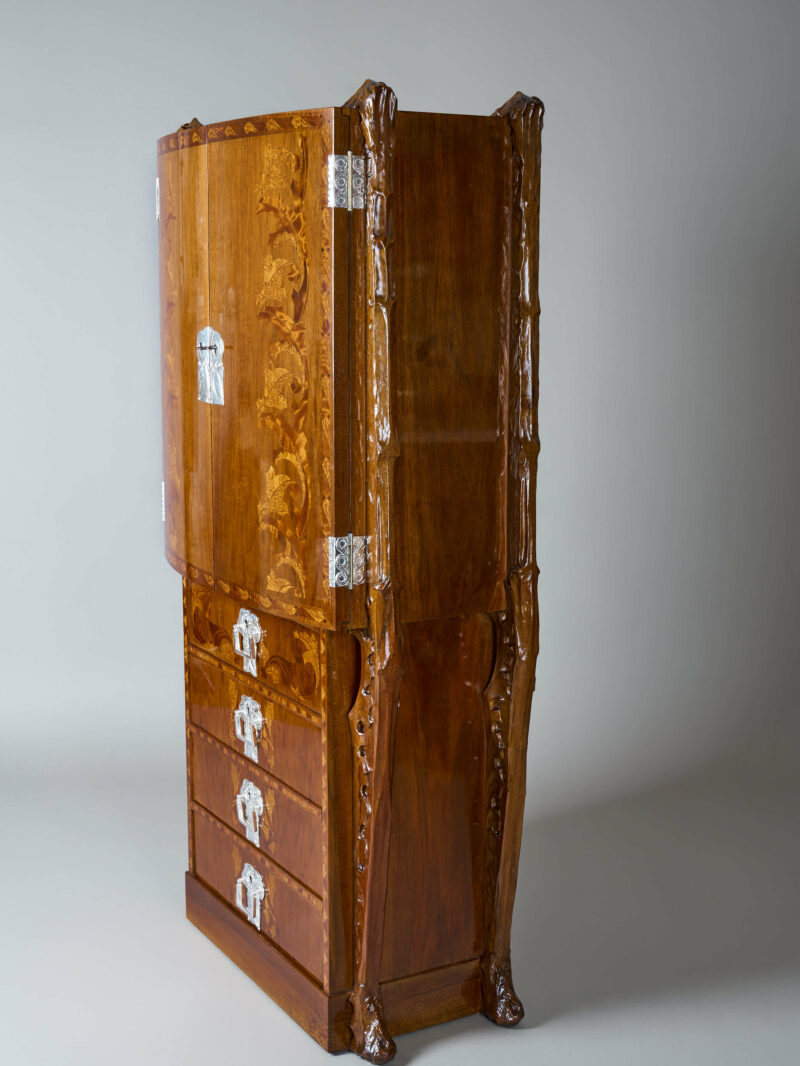
Cabinet by Viennese manufactory Bernhard Ludwig
H: 149 cm, W: 76 cm, D: 40 cm
